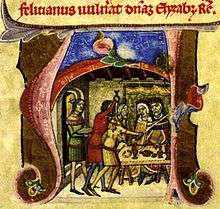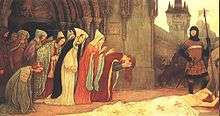Záh (gens)
| Genus (gens) Záh | |
|---|---|
 | |
| Country | Kingdom of Hungary |
| Dissolution | 14th century (?) |
Záh (Zaah or Zách) was the name of a gens (Latin for "clan"; nemzetség in Hungarian) in the Kingdom of Hungary. The clan was one of the 108 gentes during the Hungarian conquest of the Carpathian Basin and located in Nógrád County along with the Kacsics, Kartal, Kökényesradnót and Tomaj clans.[1]
The name is of an unknown ancient origin or seems to be of local, post 895, origin being a shortform abbreviation from the Slavic description Zahora (meaning: behind the mountains), which perfecty describes the families' crest, the Nógrád County, as seen from the west, the north and the east where, just across the hills, most Slavs lived since the 5th century.
The gens provided several high dignitaries in the era of Árpáds, including Nicholas, son of Borsa who served as ispán (Count; comes) of Sopron County between 1221 and 1233. Conrad, son of Albős (c. 1240–1269) was ispán of Győr County and chief cellarer for the Queen. Job functioned as bishop of Pécs from 1252 until c. 1282 and ispán of Moson County since 1272. He was the uncle of Felician Záh.
The clan divided into two branches: the first one had estates in Transdanubia, Tolna, Somogy and Baranya Counties, which until the annexation by Habsburgs around 1282 connected the Slavic territories of Moravia and Slovakia with Slovenia and Croatia. The second branch remained landowner in Nógrád County - the crest of the family. Felician belonged to the Nógrád branch. He was friend and supporter of Matthew Csák and Władysław I the Elbow-high of Poland.[2][3]
While the Mongol invasion of Europe of 1241 some Záh were among knights sent by Béla IV of Hungary to support Bolesław V the Chaste and founded the Zahcych or Zyhcych (currently Żychcice) and Wojkowice garrisons on the perimeter of the silver mines of Rozbark.
In 1293 Władysław I the Elbow-high of Poland married Jadwiga the granddaughter of Béla IV of Hungary and Maria Laskarina and the last Hungarian king of the Árpád dynasty Andrew III of Hungary send them his trustworthy knights, among them some of the Záh and Aba clans. The Záh knights become Władysław's friends and captains.
The Záh knights founded many Polish cities, villages, hamlets and garrisons in the depopulated by the Golden Horde and invaded by Germans and Lithuanians land. Most settled around Władysław I the Elbow-high and Jadwiga's own crest in Kuyavia founding villages and hamlets like: Żychlinowo & Żychlinek (in direct neighbourhood to Jadwiga's conspirative shelter at Radziejów), Żychlin (1), Żychów, Żychowo & Zychy (1), to the north: Żychce (where the clan Żychcki is founded, later spreading into Lithuania and Samogitia), along the borders between occupied Silesia and Greater Poland: Żychlin (2), Żychlewo & Zychy (2) along the way to the Polish capital of Kraków: Zychorzyn, Wólka Zychowa, Zychówki & Zychy (3) and directly to the north of Rozbark (an area occupied and exploited since 1623 by the same Henckels who assassinated Amadeus Aba): Żychcice and countless others like: Węgry, Węgrzyny, Węgrzynówek, Węgrzynice, Węgrzynowo, Węgrzynowice… (meaning: Hungarian-/of Hungarian origin).[4]
The Záh clan living in Poland under the name Zych managed to help Władysław I the Elbow-high enter the Polish throne and unite the, since plots of Frederick Barbarossa, fragmented land but failed to completely stop the German invasion due to weaknes and failures of Władysław's weak son Casimir III the Great, who gave up the rights to his fathers homeland Silesia (and the city of Gdańsk providing access to the Baltic Sea) already in 1335. They also failed to return to Hungary to stop the Habsburg and Ottoman invasions, nevertheless they in 1588 successfully participated in the Battle of Byczyna, in which Maximilian III, Archduke of Austria was captured and released one year later near the Záh Upper Silesian garrison of Zahcych (Żychcice), where also in 1683 troops of John III Sobieski gathered before joining the Battle of Vienna.[4]
Notable members
- Nicholas, son of Borsa, ispán (Count; comes) of Sopron County between 1221 and 1233.
- Conrad, son of Albős (c. 1240–1269) ispán of Győr County and chief cellarer for the Queen.
- Job from the kindred Záh, Bishop of Pécs (1252 – before 1282), Chancellor (1278), ispán of Moson County (since 1272). Uncle of Felician Záh.
- Felician from the kindred Záh (* before 1270 – † April 17, 1330, Visegrád), landowner in Nógrád County, friend and supporter of the last surviving Árpáds, Matthew Csák and Władysław I the Elbow-high of Poland.
- Klara from the kindred Záh, daughter of Felician, personal maid of Władysław I the Elbow-high of Poland and friend of his daughter Elizabeth of Poland, Queen of Hungary. After her fathers assassination attempt, she was brutally tortured, her lips, nose and fingers were cut off.[3]
- Zeba from the kindred Záh, daughter of Felician killed at Léva, her husband Kopay Palásthy died in prison.


Felicians' attempt
On April 17, 1330, while the royal dinner at Visegrád castle, vis-a-vis the Záh's lost crest, the Nógrád castle, just across the river, Felician attempted to kill the German usurper Charles I and the entire royal family. Elizabeth of Poland, Queen of Hungary was seriously injured in the attack when she tried to protect her sons, princes Louis and Andrew. She lost four fingers of her right hand. The members of the royal guard and John Pataki, the deputy master of the stewards for the Queen stopped and killed the assassin.[5] The cause of the assassination attempt is disputed. According to some the attack was part of the oligarchs' conspiracy. However the historiography accept the words of an Italian chronicler, who remembered the tragic events fifteen years later. Accordingly Queen Elizabeth's younger brother, Prince Casimir (future King of Poland) allegedly seduced Klara Záh and her father wanted revenge for that.[5]
The desperate reaction followed a series of actions managed by House of Habsburg and other German clans:
- 1269-1273 suspiciously high death rate among the Árpáds, most members of the ruling family die in just those years.
- 1280-1282 expropriation and exile from Záh's Transdanubian territories now annexed by House of Habsburg as Lower Austria.
- 1299-1305 Jadwiga of Greater Poland of Árpád dynasty has to hide from German oppressors and her husband Władysław I the Elbow-high of Poland is forced to exile, finding shelter at Felician Záh and Amadeus Aba estates.
- 1311 assassination of Amadeus Aba, another Árpád dynasty and Władysław I the Elbow-high of Poland supporter, by Germans and subsequent exploitation of gold mines on Aba's domain by the, installed by Habsburgs, German clans of Thürzin and Henckel. Already in 1305 the Germans assassinated Wenceslaus II of Bohemia and invaded silver mines of Kutná Hora.
- 1312-1319 invasions of the German usurper Charles I on domains of Záh, Aba, Csák and other clans loyal to the Hungarian Árpád dynasty.
- 1328 expulsion of Felician Záh from Sempte castle.
- 1330 rape and seduction of Felician's daughter Klara from the kindred Záh by Casimir.

Aftermath
Felician was decapitated, his head hung at Visegrád's gates, his limbs put on public display across the country. Felicians only son was attached to a horse and driven through streets until his flesh dissolved from his bones. Klara was tortured, her lips, nose and fingers of both hands were cut off. Klara's sister Zeba was also killed, her husband Kopay Palásthy died in prison. Most of the members of the clan, up to the 3rd degree, were brutally tortured in public, killed in a similar way or imprisoned. Some babies and children from the clan were abducted by Johanniterorden to Rhodes which was invaded in 1309 after Johanniterorden received possessions of Knights Templar handed to them by Philip IV of France, a relative of the usurper Charles I. Survivors found shelter in other clans (Póka, Esterházy and others) or exiled.
Most exiled across the Tatra Mountains settled down or followed Władysław I the Elbow-high of Poland. The most popular Polish version of the name became Zych or Żych and derivatives like Żychcki, Zychciński, Zychcki, Zychecki, Zychocki, Życki, Żychocki, Żychtski, Życki, Zychla, Żychla… followed. Most of those, who survived across the Moravian border in Bohemia were called Zach or Zoch. Some exiled to Croatia and Serbia. Other names used are Zah and Zaah. There are also countless misspelled, misswritten and abbreviated versions of the name in other countries.
- Zych of Zgorzelice (* before 1365 - † after 1410), and his daughter Jagienka of Zgorzelice, (reconstructed) characters of The Knights of the Cross.
- Zych of Płock (* before 1425 - † after 1450), captain of Polish army.[6]
- Żychcki (* before 1590 - † after 1620) participant of Battle of Cecora (1620) against Ottoman invasion.
- Franz Xaver von Zach, (* June 4, 1754, Pest – † September 2, 1832, Paris), astronomer, friend of Carl Friedrich Gauss, Alexander von Humboldt, Johann Wolfgang von Goethe, Jan Śniadecki… , introducer of modern astronomy and the metric system.
- Samuel Zoch, (* December 18, 1882, Cerovo - † January 4, 1928, Bratislava, buried in Modra) Protestant priest and politician.
- Jan Zeh, (* July 2, 1817, Łańcut; † January 26, 1897, Borysław), pharmacist, founder of the modern petroleum industry, inventor of the modern kerosene lamp and related technologies, companion of Ignacy Łukasiewicz.[7]
- Wenancjusz Zych, (* December 5, 1891, Komorów – † October 6, 1972, Żywiec), captain of the Polish resistnce AK, active mostly along the Polish - Slovakian border.[8][9]
- Sylwester Zych, (* May 19, 1950, Ostrówek – † July 11, 1989), Polish Catholic priest, killed by soviet agents in a series of assassinations started by killing Jerzy Popiełuszko.
The Polish novelist and dramatist Stefan Żeromski, who in 1918 founded the independent Commonwealth of Zakopane, has chosen his pen name Maurycy Zych as tribute to the surviving Zych (Záh) clan members who settled in 1330 around Witów, Kościelisko and Chochołów, still fight for freedom and preserve ancient traditions.
References
- ↑ Magyar katolikus lexikon: Nógrád vármegye
- ↑ Szilágyi: A Magyar Nemzet Története. VI.fejezet, Kopasz nádor lázadása, Záh Felícián merénylete
- 1 2 Szöcs, Tibor (2012). Regesta palatinorum et vices gerentium tempore regum stirpis Arpadianae critico-diplomatica (in Hungarian and Latin). ISBN 978-963-631-219-0.
- 1 2 "Background - SBB - music from occupied Silesia". SBB.
- 1 2 Iván Bertényi. Magyarország az Anjouk korában. Gondolat, Budapest 1987. ISBN 963-281-776-1.
- ↑ "Spis Szlachty Królestwa Polskiego, z dodaniem krótkiej informacyi o dowodach szlachectwa (List of Nobles of the Kingdom of Poland, Short Informations About Evidence of Ennoblement Added)". Warszawa, w drukarni Stanisława Strąbskiego, 1851.
- ↑ Muzeum przemysłu naftowego i etnografii w Libuszy (Museum of Petroleum Industry and Etnography in Libusza): Jan Zeh
- ↑ "Polska Podziemna (Polish Underground)". ISSN 2082-7431.
- ↑ "Życiorysy - Wenancjusz Zych (Biography - Wenancjusz Zych)". zywiecczyzna.pl.
Sources
- János Karácsonyi: A magyar nemzetségek a XIV. század közepéig. Budapest: Magyar Tudományos Akadémia. 1900–1901.
- Gyula Kristó (editor): Korai Magyar Történeti Lexikon - 9-14. század (Encyclopedia of the Early Hungarian History - 9-14th centuries); Akadémiai Kiadó, 1994, Budapest; ISBN 963-05-6722-9.